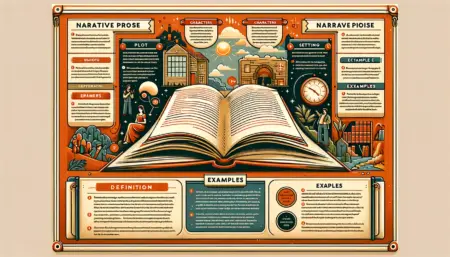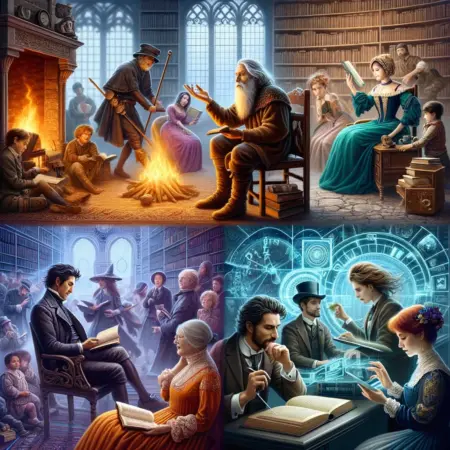Narrative prose is the natural style of speaking and writing, with absence of musicality, rhyme, rhythm and other peculiarities of the poetic structure . It consists of the everyday conversation people use to express themselves rationally.The text in prose is objective and not very ambiguous, on a certain subject, for example.

Narrative Prose is a form of writing in which the work is written in prose, instead of poetry, and tells a definitive story through actions. Many written works are written on this form, including a large amount of literary works and more modern pieces of fiction.
Stories and essays custom writing in narrative prose may still have strong and rich characters but these characters are part of the action and are not just witnesses. Prose narrative is usually written at the time of the action and tells a story through a series of events.
Narrative is storytelling — simple, direct, transparent writing that takes the reader right to the thing that happened.
Examples of Narrative Prose

- Narrative Prose
Narrative prose is an essay that tells an event (fiction / nonfiction) based on a time sequence (chronologically).
Example:
Earthquake
There was an earthquake in the area of Surabaya, East Java early this morning. This incident caused panic to the surrounding residents who are sleeping soundly. There were no casualties in this incident but some of the residents’ houses had cracks in the walls of his house.
Narrative Techniques – Narrative Ways
Narrative techniques are as follows:
– The narrator
– The kind of storytelling (ie narrative ways)
– The angle of view
– The focus
– Time of storytelling
– The narrative rate
Narrative ways are as follows :
– Narration (= telling of the story by the narrator)
– Dialogue
– Description (= description of landscapes, places and persons)
– Comments
– Free Late Logos
– Internal monologue
– Boxed narration (a minor story that is presented in the context of the main story)
Narrative ways should be distinguished from expressive ways. When we look for expressive ways, we essentially seek out what is said, the forms of speech that the narrator uses, and everything else that is related to the peculiarity of his expression.
Narrative prose in literature refers to the form of writing where the content is conveyed primarily through a narrative or a story, using sentences and paragraphs, unlike poetry which may use verses and stanzas.

This type of prose is common in novels, short stories, and biographies. Here’s a table to illustrate this concept with examples:
| Type of Narrative Prose | Definition | Examples |
|---|---|---|
| Novel | A long fictional narrative with a complex plot. | “Pride and Prejudice” by Jane Austen |
| Short Story | A brief fictional narrative with a simple plot. | “The Lottery” by Shirley Jackson |
| Novella | A work of fiction longer than a short story but shorter than a novel. | “The Metamorphosis” by Franz Kafka |
| Biography | A detailed description of a person’s life. | “The Story of My Life” by Helen Keller |
| Autobiography | A person’s biography written by themselves. | “Long Walk to Freedom” by Nelson Mandela |
| Fable | A short story conveying a moral, often with animals as characters. | “The Tortoise and the Hare” from Aesop’s Fables |
| Fairy Tale | A fictional story involving magical and fantastical elements. | “Cinderella” as retold by Charles Perrault or the Brothers Grimm |
| Historical Fiction | A story set in the past, often with real historical figures or events. | “War and Peace” by Leo Tolstoy |
This table categorizes various types of narrative prose, providing definitions and classic examples of each type. This format helps in understanding the different forms narrative prose can take in literature.
Tips for Writing Narrative Prose in Literature
To effectively incorporate narrative prose in your writing, consider the following tips:
- Develop Engaging Characters: Create well-rounded characters that readers can invest in emotionally. Give them unique personalities, motivations, and conflicts to make them relatable and compelling.
- Build a Strong Plot: Craft a cohesive storyline that keeps readers engaged from beginning to end. Focus on creating tension, conflict, and resolution to maintain the narrative flow.
- Use Descriptive Language: Paint vivid scenes with your words, using sensory details to transport readers to the setting of your story. Engage all five senses to make the narrative more immersive.
- Employ Dynamic Dialogue: Dialogue brings characters to life and adds depth to the narrative. Use dialogue to reveal personalities, advance the plot, and create tension or humor.
- Evoke Emotions: Use language and storytelling techniques to evoke emotions in readers. Whether it’s joy, sadness, or fear, the ability to touch readers’ hearts is a hallmark of exceptional narrative prose.
Conclusion
Narrative prose in literature serves as a powerful tool for storytelling, enabling authors to captivate readers and explore the depths of human experiences. Through novels, short stories, and personal essays, narrative prose transports us into different worlds, engages our emotions, and offers fresh perspectives. By understanding the nuances of narrative prose and employing effective writing techniques, we can craft compelling narratives that leave a lasting impact on readers.
